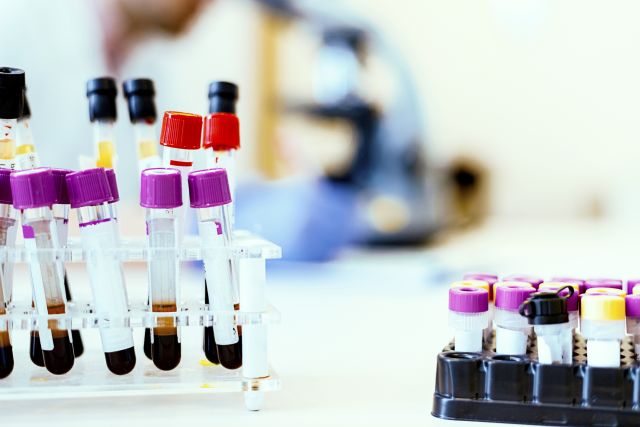If you or a loved one has been diagnosed with acute myeloid leukemia (AML), your healthcare providers will discuss molecular testing (also known as genomic testing and biomarker testing). These are tests that look closely at the genetics and biology of cancer cells. The results of these tests can help your healthcare providers decide on the best approach to treating AML.
As with any aspect of cancer treatment, it helps to have a good understanding of the basics. Here, we look at gene mutations, what to expect from molecular testing, and how targeted therapies work.
What are genetic mutations?
There are many, many different types of cancer, but all cancers begin in basically the same way—with changes to the genes of normal cells. A few key terms to review:
- DNA. DNA is genetic material found mostly inside the nuclei of cells. DNA can create exact copies of itself, which is how genetic information is carried from cell to cell as cells divide and multiply.
- Gene. Genes are specific sections of DNA that contain instructions for specific functions. Many genes provide instructions for making different proteins, which are the building blocks for all the structures and substances of the body.
- Chromosome. Inside the nuclei of cells, DNA is packaged into structures called chromosomes. Under normal circumstances, each nucleus contains 23 pairs of chromosomes (for a total of 46).
Mutations are changes to genes. In most cases, mutations occur and have no effect on a person’s health. Sometimes, mutations cause genes to function differently and can result in disease. Cancers occur when there are mutations to the genes that control the normal lifecycle of cells—how cells divide and repair, and when cells die off so new cells can take their place. Cancerous cells grow uncontrollably.
Most cancers occur because of acquired mutations—damage to genes caused by things like smoking, exposure to radiation or chemicals, or other diseases. In most cases, it’s not a single mutation that causes cancer, but several mutations.
How do healthcare providers identify mutations?
There are laboratory tests that can identify specific gene mutations and chromosome abnormalities. These tests are used to determine the subtype of AML, the risk of the cancer relapsing after treatment, and what therapies are the best choice for treating the cancer.
This type of diagnostic testing may be referred to as molecular testing, biomarker testing, and genomic testing. Instead of testing, it may be called “profiling” or “sequencing.” If you have questions about what tests are being ordered and why, ask your healthcare provider.
How are these tests conducted?
Gene mutations and chromosome abnormalities are identified using complex lab procedures that examine AML at the cellular level. But for a person with AML, testing is a straightforward process where your healthcare providers take samples of blood and/or bone marrow.
How do targeted therapies work?
Targeted therapies are anti-cancer drugs designed to attach to cancer cells (while mostly ignoring normal cells). Some work by inhibiting cancer cells’ ability to divide. Other targeted therapies work by delivering chemotherapy drugs to cancer cells with greater precision than standard chemotherapy drugs.
For example, the most common gene mutations found in AML affect the FLT3 gene. Mutations to this gene are identified in roughly one-third of people who have AML. The FLT3 gene contains instructions for making a protein found on the surface of cells. This protein plays an important role in the growth and division of immature blood cells (as well as other processes that take place at the cellular level).
If a person has AML with an FLT3 mutation, they might be treated with a type of targeted therapy called FLT3 inhibitors. This type of medication works by blocking the FLT3 protein (along with other proteins found on cancer cells), slowing the growth and spread of cancer.
This is just one example. There are multiple other targeted therapies that work by targeting other gene mutations that make other proteins, and other targeted therapies are under development.
It’s important to remember that there is no best approach to treating AML, only the approach that is best for a particular person at a particular time. Along with gene mutations, there are always other factors to consider—a person’s age, overall health, and other health conditions—and your healthcare providers will be your best source of information.






